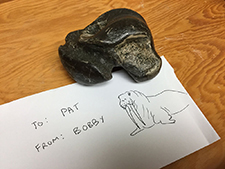EPICC TCN participants at our 2016 annual meeting at the Burke Museum in Seattle, WA including UCMP/UC Berkeley alumni Liz Nesbitt ('82), Edward Davis ('05), Jann Vendetti ('09).
EPICC TCN participants at our 2016 annual meeting at the Burke Museum in Seattle, WA including UCMP/UC Berkeley alumni Liz Nesbitt ('82), Edward Davis ('05), Jann Vendetti ('09).
UCMP is now two years into a large-scale digitization project focused on fossil marine invertebrates from the eastern Pacific: EPICC. Led by Museum Scientist Erica Clites and Staff Assistant Lillian Pearson, a group of 14 undergraduate students and 4 graduate students (Peter Kloess, Mackenzie Kirchner-Smith, Nick Spano, Susan Tremblay) have cataloged 21,000+ fossil specimens, georeferenced nearly 4000 localities and taken 700+ photographs. Together with our eight museum collaborators listed on epicctcn.org, the EPICC Thematic Collections Network (epicctcn.org) has completed 42% of our specimen digitization, 26% of our specimen photography and 38% of our locality georeferencing. Five museum partners are serving data to biodiversity aggregators such as GBIF and iDigBio.
The results of this project will be 1.6 million invertebrate specimen records that can be used to study faunal responses to environmental change over 66 million years of Earth's history along the longest continuous coastline in the world.
_225.jpg)
_1_150.jpg)
(left) UCMP 201487, Cyclocardia ventricosa, Pleistocene Epoch, Santa Barbara County, CA. Photographed by UC Berkeley undergraduate student Costas Soler, copyright UCMP.
(right) UCMP 203591, Kelletia kelletii, Pleistocene Epoch, Baja California, Mexico. Photographed by UC Berkeley undergraduate student Costas Soler, copyright UCMP. Find these and other images of fossils at calphotos.berkeley.edu.
We have published several guides on our website, including a guide to labeling marine invertebrate fossils and a guide to photographing marine invertebrates. The EPICC project also involves several UCMP/UC Berkeley alumni, including Liz Nesbitt (Burke Museum, University of Washington), Edward Davis (University of Oregon) and Jann Vendetti (Natural History Museum of Los Angeles County).
We are very close to launching the first set of EPICC Virtual Field Experience modules, which will reconnect fossil specimens with the field localities where they were collected. Lisa White and colleagues at the Paleontological Research Institution are leading this effort. The modules include video footage, Gigapan macro images, photographs of outcrops and other rich sources of data to guide inquiry.

UCB alum Wayne Thompson, now a science teacher in Los Gatos, has been scouting the Santa Cruz County cliffs since the 1980s and made a number of interesting discoveries. The most recent discovery is a walrus ankle bone (astragalus) from the Purisima Formation near Capitola, which Wayne generously donated to UCMP. After some preparation, it became obvious that the bone belongs to the walrus Valenictus - an extinct walrus that had extremely dense bones. Based on skeletons from the San Diego Formation, Valenictus was "toothless" - lacking all of its teeth aside from the enlarged tusks. Two possible skulls of Valenictus from the Purisima Formation may further represent this species, but require further preparation and study. Wayne's fossil is the first confirmable record of the toothless walrus from Northern California and the first from the Purisima Formation, the fossil assemblage which UCMP Research Associate Bobby Boessenecker is documenting. Pliocene marine rocks from California and Baja California have yielded a bizarre fauna including temperate belugas, long snouted 'river dolphins', proto-gray whales, giant sea cows, a more diverse porpoise fauna including bizarre benthic feeding species, dwarf benthic feeding baleen whales, double-tusked walruses, and of course, Valenictus. This fauna is quite different from modern counterparts, indicating a non-trivial degree of faunal change during the Plio-Pleistocene.